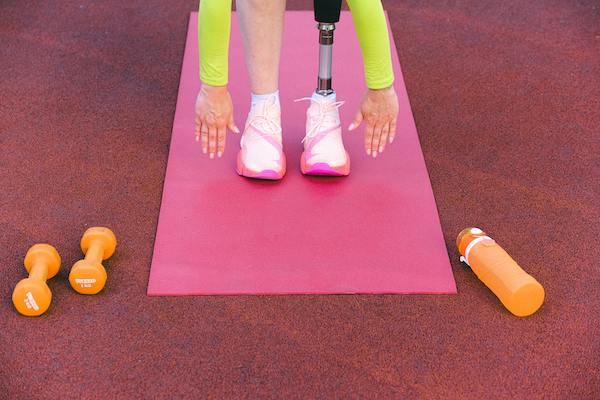Even though it is still summer, athletes need to look forward to their upcoming fall sports seasons. While summer is an ideal time for rest and recovery, the goal is to maintain overall fitness, use that extra time in your schedule to work on developing skills—and as the summer comes to an end– start working on goals for the fall.
Whether you’re gearing up for football, soccer, cross country, or any other fall sport, the summer off-season offers a crucial time to prrepare physically and mentally. A well-structured training program can make all the difference when it comes to starting the season strong and keep the risk of injury low.
Here are some training tips for youth athletes to make the most of the summer off-season and prepare for fall sports.
1. Set Fall Goals
Setting specific, measurable goals for the off-season is a great idea when taking off in the summer. The same is true when picking back up a more intensive training plan for the fall. Goals could be improving strength, increasing endurance, enhancing technical skills, or recovering from past injuries. Establishing clear objectives helps keep training focused and provides motivation. For example, a soccer player might aim to improve their sprinting speed and ball control, while a cross country runner may focus on increasing their mileage and endurance.
2. Create a Balanced Training Plan
To prepare for fall sports, it’s important to add various components to your training plan. This includes cardiovascular fitness, strength training, skill development, flexibility, and rest.
Here’s a breakdown of what to include:
Cardiovascular Fitness: Improve your aerobic base with regular cardio workouts such as running, cycling, swimming, or even brisk walking. The goal is to build stamina and endurance, which are crucial for sustaining performance throughout a game or race.
Strength Training: Incorporate exercises that target major muscle groups, focusing on functional movements relevant to your sport. For example, soccer players can benefit from leg exercises like squats and lunges, while upper body strength is vital for football players. Don’t neglect core workouts, as a strong core is essential for stability and power in almost every sport.
Skill Development: Use the off-season to refine sport-specific skills. This could mean practicing ball handling for basketball, footwork drills for soccer, or perfecting your running form for track and field. Runners can also work on speed or distance goals. Consistent practice helps maintain and enhance these skills, ensuring you’re sharp when the season begins.
Flexibility and Mobility: Incorporate stretching and mobility exercises to maintain flexibility and prevent injuries. Yoga or dynamic stretching routines can improve range of motion and muscle elasticity.
Rest and Recovery: Overtraining can lead to burnout and injuries. Make sure your training plan includes adequate rest days. Sleep, proper nutrition, and hydration are also critical components of recovery.
3. Gradual Progression
One common mistake during off-season training is increasing intensity too quickly. After taking a little time off, it’s important to gradually progress training to avoid injuries. Start with a lower intensity to get back into the swing of things and slowly increase the difficulty, whether it’s the weight you’re lifting, the distance you’re running, or the complexity of the drills. This approach allows your body to adapt and build resilience.
4. Incorporate Cross-Training
Cross-training involves participating in different types of physical activities to improve overall fitness and reduce the risk of overuse injuries. For example, a basketball player might benefit from swimming to improve cardiovascular endurance without the joint stress of running. Use the summer as a great way to try a new sport or use all the time at the pool as a way to get in a good workout. Cross-training also keeps workouts interesting and can enhance athletic performance by developing different muscle groups.
5. Focus on Nutrition and Hydration
Proper nutrition and hydration are foundational to any training program—especially leading into fall training after the hot summer. During the summer, staying hydrated is especially crucial due to higher temperatures and increased sweat loss. Athletes should drink plenty of water throughout the day, not just during workouts. A balanced diet rich in proteins, carbohydrates, fats, vitamins, and minerals supports energy needs and muscle recovery. Eating a variety of whole foods, including fruits, vegetables, lean proteins, and whole grains, helps ensure adequate nutrient intake.
6. Mental Preparation
Mental toughness and focus are just as important as physical readiness. Use the summer to work on your mental game. Visualization techniques, goal-setting exercises, and mindfulness practices can help improve concentration and reduce anxiety. Read a book that will boost motivation such as a self-help option or a biography on your favorite athlete. Use summer vacation or time at the beach for time dedicated to a good summer sports read. Mediate near the ocean or when star gazing while camping. Mental conditioning helps athletes stay calm under pressure and maintain focus during competitions.
7. Seek Professional Guidance
For athletes looking to take their performance to the next level, working with a coach or trainer can provide personalized guidance and accountability. Even though the summer is coming to a close, there are still sports camps and clinics running until the end to help boost performance. A professional can tailor a training program to your specific needs, monitor progress, and adjust the plan as necessary. They can also provide valuable insights into technique and form, which are crucial for preventing injuries and optimizing performance.
8. Listen to Your Body
While it’s important to push your limits, it’s equally crucial to listen to your body. Pain, excessive fatigue, and prolonged soreness can be signs of overtraining or injury. If you experience any of these symptoms, don’t hesitate to take a step back and rest. Recovery is a vital part of the training process and helps prevent long-term issues.
It’s fine to use part of the summer as a time to recover and rest up, but remember to stay active even without the pressures and start to build back consistent training heading into the fall.

